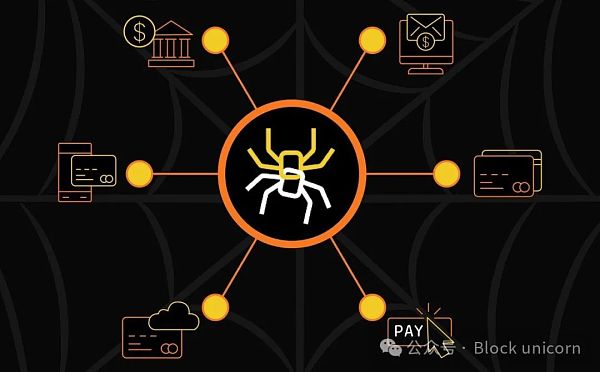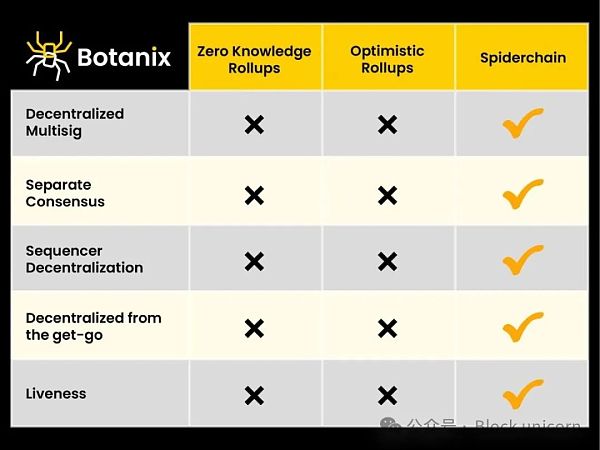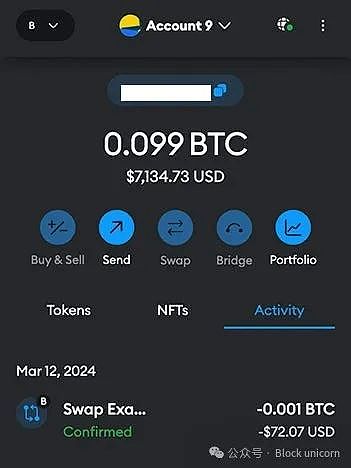Article author: AYLO
Botanix is a Bitcoin Layer 2 network equivalent to the Ethereum Virtual Machine. They currently have a complete working product on the testnet and I think it will be one of the most exciting Bitcoin related projects this year. I spoke with Botanix Labs founder Willem Schroe to learn more and better understand his views on Bitcoin Layer 2.

Botanix Lab is developing the first fully decentralized Layer 2 network based on Bitcoin, which has functions equivalent to the Ethereum Virtual Machine (EVM refers to the Ethereum Virtual Machine). In this network, the convenience and versatility of the Ethereum Virtual Machine are combined with the decentralization and security of Bitcoin.
Botanix will utilize Bitcoin's Proof of Work (PoW) as the basic settlement and decentralized Layer 1 (one-layer main network). On Layer 2 (second layer), Botanix will adopt a proof-of-stake consensus model, and users can safely store their Bitcoins (interests) on Spiderchain.
Spiderchain is a decentralized network developed by Botanix Lab for storing user-pledged Bitcoins. The network consists of a decentralized set of multi-signature accounts, managed and maintained by randomly selected participants. Spiderchain is designed to keep users’ pledged funds safe and decentralized, providing a secure foundation for Botanix Labs’ Layer 2 network.
Tell us about yourself and how you started creating Botanix?
I grew up in Belgium and eventually became a national champion in math there. I later completed my bachelor's and master's degrees in electrical engineering. Belgium has a great reputation in cryptography, so my master's degree was actually focused on cryptography. I did some research on authenticated encryption and even managed to crack some encryption algorithms. At the time, I had no idea that cryptography would eventually have an impact on my career again.
After graduation, I worked in the chemical industry for six years and two years in Saudi Arabia. Being in the Middle East, and especially seeing the hyperinflation in Lebanon, I fully realized the importance of cryptocurrencies. This led me to apply to Harvard Business School, which was my entry into the United States.
At Harvard, I proposed Botanix's theory, and our theory has remained virtually unchanged ever since. A year and a half ago, I was trying to understand where cryptocurrency infrastructure was heading. Interestingly, the theory about infrastructure has been changing for 15 years. However, our theory is simple, we view Bitcoin as a purely decentralized, secure form of currency with almost no utility built on top of it. So you have this huge pool of potential money just waiting for something to be built on top of it.
Building things on Bitcoin is actually very difficult, as everyone realizes now. At the same time, outside of Bitcoin, there is a huge amount of utility and applications, many of which already have product-market fit, creating huge value.
I realize that these are all built on so-called virtual machines. A virtual machine is essentially a software layer that follows the same principles as software technology. II realize that the Ethereum Virtual Machine (EVM) is the most prominent virtual machine with the most extensive network effects. In the war of software technology, the coverage of technical network effects is the most important part. When you look at Windows in the 1980s, it wasn't the best technology, it wasn't the most secure, but it had by far the greatest network effect reach.
In the software technology war, the coverage of technology network effects has always been key. So while Bitcoin may be winning in monetary terms, it is the Ethereum Virtual Machine that is winning. This led to the idea of building a second layer on top of Bitcoin, which sets us apart. The idea came up a year and a half ago, and we spent the first six months diving back into cryptography and developing a fully decentralized second layer for Bitcoin, which we called Spiderchain. Spiderchain is the ability to build a second layer. Technology.

We have received positive feedback and reviews from many people in the Bitcoin community. We started building it and unveiled it in September of 2020, launched our public testnet in November and are now preparing to launch the mainnet. I believe we are the only one that has actually delivered a full end-to-end working product team.
Can you give a brief overview of how Botanix works?
We are fully EVM compatible, so anything that runs on the EVM, you can copy-paste on Botanix and the entire system will Runs on top of Bitcoin. Once you connect to MetaMask, you will generate a Bitcoin deposit address. This looks like a normal Bitcoin address, but in fact, it is a special type of address and in Taproot we encode your EVM address.
Block unicorn comment: Taproot is an upgrade of the Bitcoin network. This upgrade is to improve privacy, security, and scalability.
This means that from now on, this Bitcoin address is uniquely connected to the EVM address you obtained from MetaMask. We do this because we saw what Stacks and Rootstock did and what they got wrong. We want to make it as easy as possible for people to join Bitcoin's second layer, so the process from Bitcoin to Botanix will feel as easy as bridging from Ethereum to a second layer like Arbitrum.

Basically, with this address, you can now send Bitcoin directly from Coinbase, Kraken, or any exchange to this Bitcoin deposit address and then you can own those Bitcoins in MetaMask. From that point on, it feels like being on Ethereum, but you're doing everything in Bitcoin.
Which users do you think Botanix will attract - Ethereum L2 users or Bitcoin natives?
I think the answer is a little bit of both. In the cryptocurrency space, people often compare Bitcoin and Ethereum, and they may be more ideologically inclined to one over the other. Some people prefer Bitcoin because it represents a fully decentralized currency, which is most important to them. Others are leaning more toward Ethereum, focusing more on its practicality. However, I think the end users will come from two areas.
I know a lot of Bitcoin holders who actually want to earn income on their Bitcoins. But there is actually no applicable method. I know a lot of people want to use their Bitcoin on some perpetual contract decentralized exchange, but it's not possible to do so natively on Bitcoin. So this essentially allows any application that has achieved product market fit on Ethereum to also achieve product market fit on Bitcoin. I've always had a theory that even Bitcoin holders are just regular people who behave very much like everyone else. Therefore, any application that has reached product-market fit on Ethereum has the potential to reach product-market fit on Bitcoin; there just isn't the infrastructure to actually do it.
I think these special types of digital assets and BRC-20 tokens show that many Bitcoin users also have an explorer spirit and are eager to try various activities, but There are currently no options on the market for them. I have observed that in the past few months, we have been vigorously developing the business, and from a developer's perspective, if you are an Ethereum DApp and choose to deploy on Arbitrum or Ethereum, you will face fierce competition. Competition for the same users and capital. Additionally, choosing to deploy on Botanix gives you the opportunity to be a first mover in the entire Bitcoin market, attracting all Bitcoin holders who want to take advantage of Bitcoin.
I think 70% of the people or capital will actually come from native Bitcoin, and all the dead capital waiting for use on Bitcoin will come from Here, another part of the capital will come from Ethereum.
Are developers also interested in building native applications on Botanix?

Bitzy team is building a very novel new DEX that uses V2 front-end but uses V3 aggregator on the back-end, similar to the logic of Ethereum DEX. The Vertex team is building the next generation of perpetual contract applications, improving existing proof models. Other well-known sustainable DEXs are also considering deployment.
Palladium will announce the use of a Bitcoin-backed stablecoin, which is a huge application in itself. Many people have tried to create stablecoins on Bitcoin, but so far they have not been successful. However, the biggest application of encapsulated Bitcoin on Ethereum is to essentially have a stablecoin that is secured by encapsulated Bitcoin, like MakerDAO's DAI, but localized and decentralized on Bitcoin itself which makes more sense. So the Palladium team is entering this space of having Bitcoin-backed stablecoins on Bitcoin itself.
Then, there are a bunch of different lending agreements. The most obvious use cases on Bitcoin are those that have already achieved product-market fit on Ethereum. Some are considering venturing into unique areas of Bitcoin, such as mining hashrate. Others are interested in building commodity DEXs, which may be more aligned with Bitcoin holders and their macroeconomic interests. But overall, the focus is on bringing applications that have already reached product-market fit on Ethereum to Bitcoin.
Can people use BRC-20 tokens on Botanix?
As you may know, the current user experience of BRC-20 tokens is quite poor. Basically, you'll be able to move from Bitcoin's mainnet to Botanix's second layer via a chain bridge, and then you'll suddenly be able to have 9 second blocks (super fast network), start trading on the DEX, start trading on the protocol Trade in and basically have access to the entire ecosystem of the ERC-20 DeFi ecosystem, so to speak.
Are you planning to compete with high-throughput chains? Or want to create your own niche?
Excellent question, the answer is no. I think the game changer here is that we provide the infrastructure on Bitcoin. In fact, Spiderchain is designed more like Ethereum. We have the ability to support 10,000 to 100,000 different full nodes, and anyone can join the network, stake Bitcoin, and run a full node. Therefore, this is also more attractive to Bitcoin holders as they prefer decentralization.

This is a major shift in this area. The blockchain trilemma, if you pursue high throughput, will limit your decentralization. We, at Botanix, the second layer is really following the Ethereum vision of requiring more hardware but still running with 9-10 second block times, while being able to be extremely decentralized. This vision favors decentralization rather than large-scale high throughput. We believe this is one of the main reasons why we are widely recognized by the Bitcoin community, where our strong stance on decentralization is fully recognized.
What will the fees be like on Botanix?
The fees on Botanix will be very low. Current roll-ups are quite centralized in nature, leading to various problems and higher costs. To resist censorship, maintain liveness, and unilateral withdrawals, they need to push data back to Layer 1, increasing the cost of Layer 2. In contrast, we are fully decentralized and anyone can run a full node, solving these problems. Therefore, our Tier 2 fees will be very low. We may not be able to achieve extremely high speeds, but our fees will remain low because we won’t have to submit data to the Bitcoin mainnet, which would be very expensive.
What about speed?
Botanix is optimized like Ethereum. We have similarities with Ethereum in terms of the blockchain trilemma and fast processing speed. at. However, it is also possible to build a third layer or even a 2.5 layer that connects directly to Bitcoin as the base layer and achieve massive speeds. The Ethereum Virtual Machine (EVM) will serve as the data availability layer, while the core of Spiderchain is to achieve decentralization on top of Bitcoin’s base layer. This design is similar to EigenLayerbut applied on the Bitcoin network so we can achieve very fast roll-ups in it. This represents our long-term vision. In the future, we can develop further and achieve goals similar to Solana or faster roll-ups on the Bitcoin network.
What is the size of the "sleeping capital" on the Bitcoin network?
The basic idea is that the total market capitalization of Bitcoin is three or four times that of Ethereum. Preliminary data shows that, in fact, the market cap ofOrdinal and BRC-20 tokens — is 3 times the initial market cap of the Ethereum NFT market.
We also believe that the DeFi market on Bitcoin will be three times the size of Ethereum. I think out of a trillion dollar market cap, considering all the Bitcoin in ETFs, in the wallets of long-term holders, and about 20% of the extreme Bitcoin Maxis (Bitcoin Maxis) don’t want to do anything with their Bitcoin , approximately 30% of the Bitcoin supply will be fully open. When you consider that Bitcoin is a trillion-dollar asset, the DeFi market could easily reach $100 billion.
 JinseFinance
JinseFinance
 JinseFinance
JinseFinance JinseFinance
JinseFinance JinseFinance
JinseFinance JinseFinance
JinseFinance JinseFinance
JinseFinance Cheng Yuan
Cheng Yuan Coinlive
Coinlive  decrypt
decrypt dailyhodl
dailyhodl 链向资讯
链向资讯